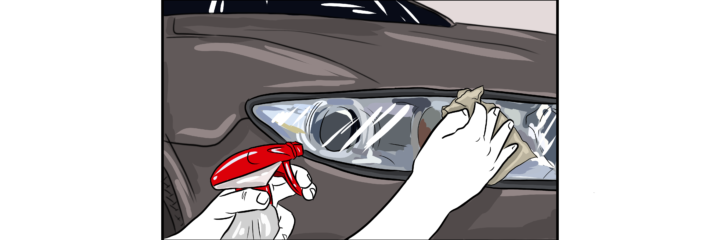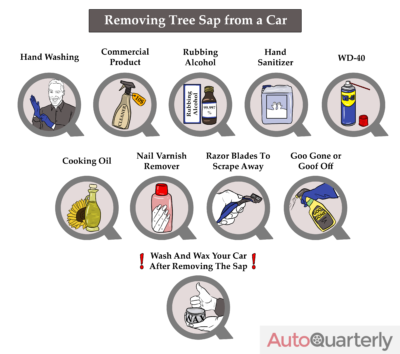You may not think twice about parking your car under a tree. Then, all too often, when you come back to your vehicle, you find sticky spatters all over the surface of your car – that is tree sap.
It may be hard to remove tree sap from your vehicle, but it’s a chore that needs to be done. Indeed, if tree sap is allowed to remain on your car’s surface it will eventually turn black and become even more challenging to remove. It may even damage the paintwork over time if left in place. Although tree sap doesn’t damage the paint of a vehicle immediately, time is still of the essence. Sap eats through the clear coating and leads to the paint becoming stained and discolored.
If you thought that taking your car through a car wash would get rid of the sticky substance, think again. It’s time-consuming and labor-intensive to remove tree sap from your vehicle. If done incorrectly, it could also end up causing scratches on the paint.
Knowing how to remove tree sap from a car safely and carefully is therefore important, so we’ve outlined several methods here that can get the job done quickly and without damage.
Hand Washing Your Vehicle
The first thing to try is to hand wash your vehicle as quickly as possible. This method doesn’t always work, but if you act swiftly enough you may be in luck. It’s always a good idea to try hand washing first before you attempt anything more strenuous or complex. As a minimum, this method ensures the surface of the car is clean should another method be required.
You should wash your car by hand as quickly as possible after the sap has dripped onto your vehicle to prevent it from having time to harden. The sooner you attack the sap, the less effort you’ll need to put in to get rid of it.
You will need:
- Hot water
- Car soap
- A microfiber cloth, sponge or wash mitt
First, rinse the surface of your car using a pressure washer if possible. If you don’t have access to one, use a standard hosepipe and a pressure nozzle. Spray all the debris on the vehicle’s surface as well as the sap for a thorough rinse.
Next, it’s time to use a clean microfiber cloth, wash mitt or sponge to scrub the car. This is a vigorous task, so be prepared to put in some serious effort. Use soapy hot water and clean the whole vehicle. Make the water as hot as you can bear as heat helps to break the sap down. Scrub the areas covered in sap extra hard.
Next, rinse away the soap and any sap that has been removed off the car. Should some sap still remain, scrub the areas once more before rinsing again.
Once the sap has gone, dry your car thoroughly and then wax it to ensure the clear coat and the paintwork are properly protected.
Use a Commercial Product
If hand washing your car doesn’t work, you will need to move on to a more involved method.
Several commercial products have been designed to get rid of contaminants like bugs, tar, and sap and you should be able to find them for sale in an auto parts store. These powerful products have a formulation that is tough on contaminants but gentle on your paintwork. Make sure, though, to always read the warnings and directions on the packaging and adhere closely to the instructions to ensure no unintentional damage occurs to the paint.
All products have their own specific instructions, but the usual method of use is as follows:
You’ll need:
- A microfiber cloth
- Commercial sap removal product
- Wax
- Soap
Apply the commercial removal product to the area that is covered in sap. Apply the remover to a clean microfiber cloth and put the cloth on the sap-covered area. Allow the product to soak into the surface for a minimum of 30 seconds. This should help the sap to loosen. Once this has happened, rub the spot with the cloth in a circular motion. Avoid smearing any sap over the vehicle’s surface. If any sap remains, use a fingernail to scratch it away, but take care that you don’t scratch the paintwork. Finally, wash the car to remove any residue that remains and apply wax to protect the car’s newly clean surface.
Using Rubbing Alcohol
If neither of the above methods work, there are some products that are found in most homes that can be effective at removing tree sap on your car. Rubbing alcohol is one such product. Take care though to only apply it at first to a well-hidden spot on your car until you’re sure it won’t cause any damage to the paintwork.
Pour some rubbing alcohol onto a clean microfiber cloth and place it onto the sap-covered area. Allow it to soak in. This will help to break the sap down until it can be rubbed away completely. Avoid leaving the rubbing alcohol in contact with the vehicle’s paintwork for extended periods though, as it could damage the clear coat and the paint. Afterward, wash the affected area with soapy water to ensure all remaining traces of rubbing alcohol are removed.
Try Hand Sanitizer
Hand sanitizing products are primarily made up of alcohol, so they should be quite effective when it comes to the removal of tree sap. You should follow the procedure outlined above for using rubbing alcohol and remember not to allow the sanitizer to remain on the affected spot for extended periods of time as it could cause damage to the paintwork.
Using WD-40
Many people have WD-40 lubricant at home. This can be used to remove tree sap from your car either alone or when used together with rubbing alcohol. Simply apply generously to the spot of sap and allow it to sit for a while to break the sap down. Then, rub the sap away and wash the affected area with soapy water.
Try Cooking Oil
Although it may sound unlikely, cooking oil has been shown to be effective in some cases on tree sap, particularly if the spot is quite fresh. One great advantage of using this method is that it isn’t toxic and won’t cause any damage to the paint job. Just apply the cooking oil to the tree sap directly and allow it to rest for several minutes before wiping away and cleaning the area with soapy water. Bacon grease may also work equally well if you’re planning to use this option.
Experiment With Nail Varnish Remover
You can also try using nail varnish remover to get rid of the sap on your car’s surface. You can do this by pouring a little polish remover onto a cloth or cotton ball then wiping it onto the sap. You should see the sap coming off quite quickly. Once it has all gone, wash the residue away using a paste made up of water and baking soda. This will ensure no paint comes off too. Finally, wash the car with soapy water and wax the area to restore the original luster of the paintwork.
Try Scraping the Sap Away
If no other methods have been successful in removing the hardened sap from your car’s surface, you may want to try scraping it off. You can use razor blades to scrape the sap away, applying WD40 or rubbing alcohol first to soften and loosen the sap first. If you decide to try this method, be aware that patience and a steady hand are vital or you could damage the paintwork.
Use Goo Gone or Goof Off
Both Goof Off and Goo Gone are products that have been specially formulated for the removal of gunk and tough stains like sap. If you opt for this method though, you should take care to test it on a well-hidden spot on your car to check whether it causes any damage to the paint. Simply apply the product to a clean microfiber cloth and allow it to soak into the surface before you begin rubbing. After the sap has been removed, use soapy water to clean the affected area and to remove any product that remains.
Restoring Your Car’s Surface Sheen
If you were wondering how to remove tree sap from a car, you can see that there are several options open to you. None are foolproof, and some are more effective than others, so you may need to experiment to find the one that works best for you. Whichever method you use, you should always remember to wash and wax your car after removing the sap to remove any product residue that remains and to protect the clear coat and paint job of the vehicle.
If you still aren’t sure which method would be best for your car, or you’re worried that you might cause damage to the paintwork by trying to remove the tree sap yourself, you should contact your mechanic who can offer you professional advice.



